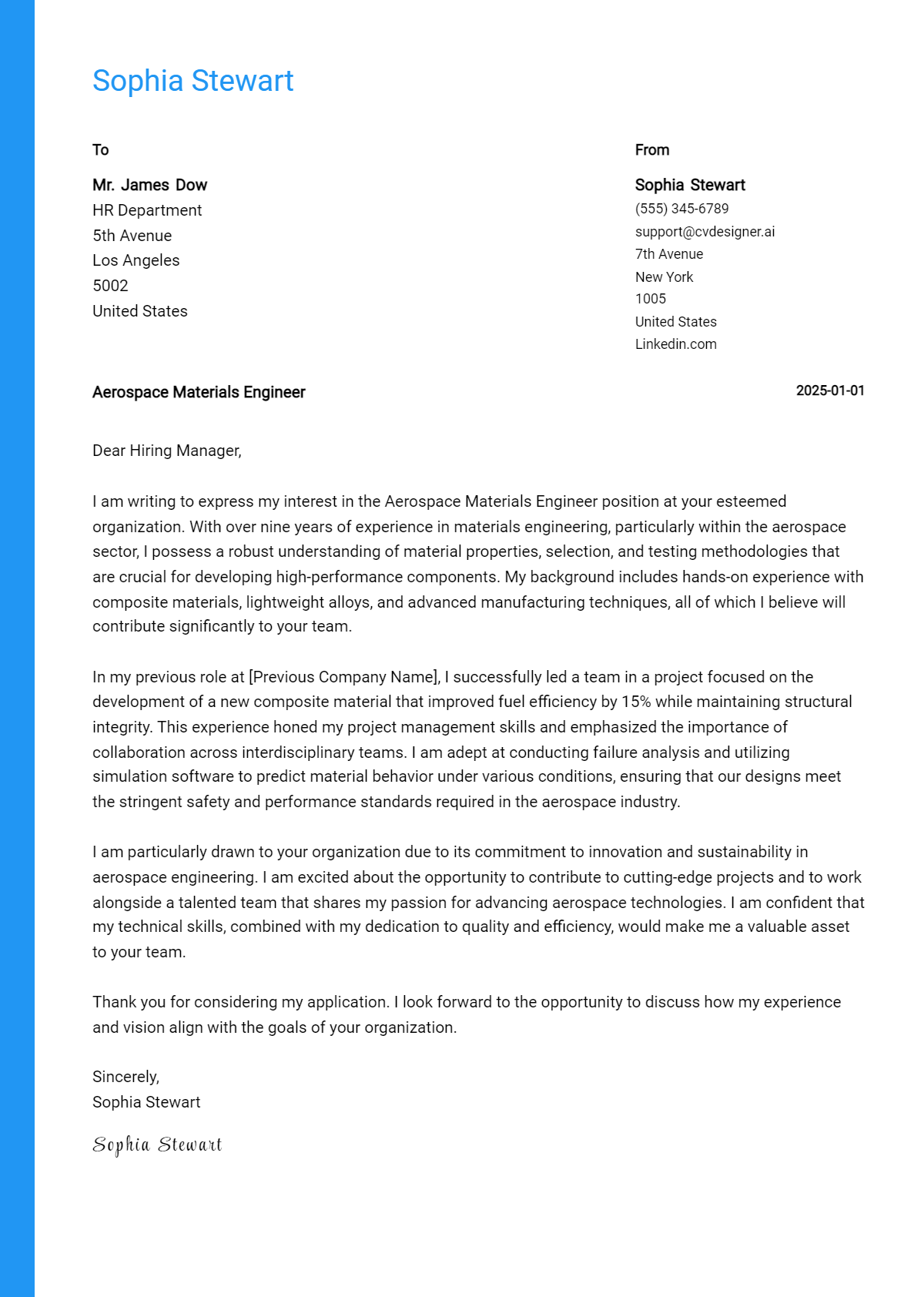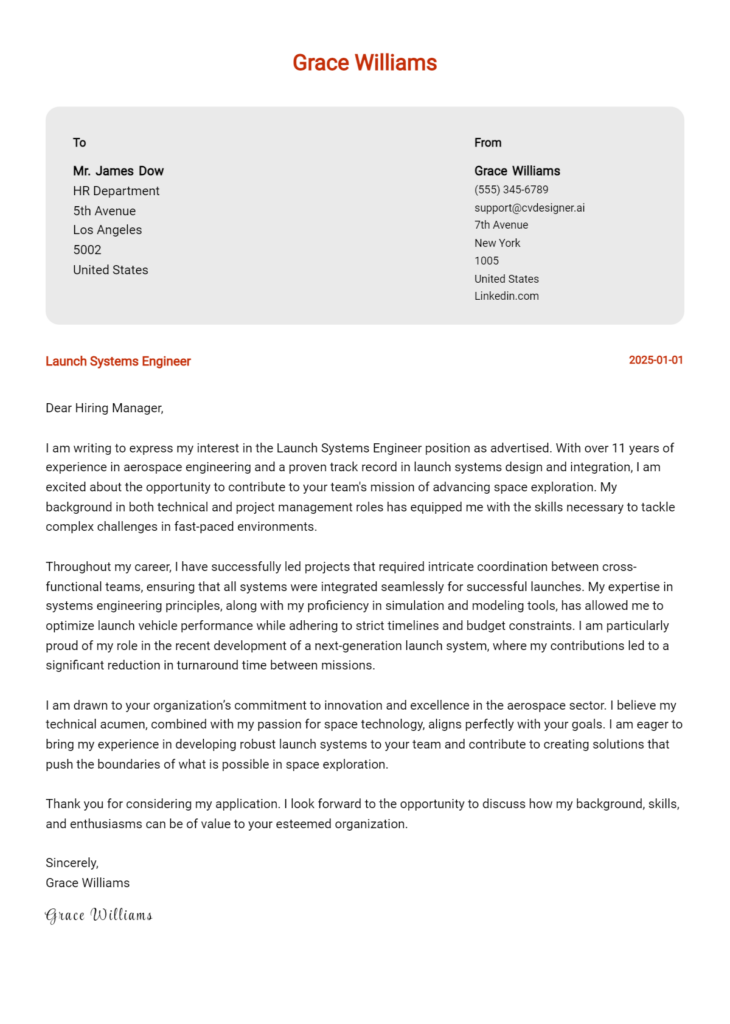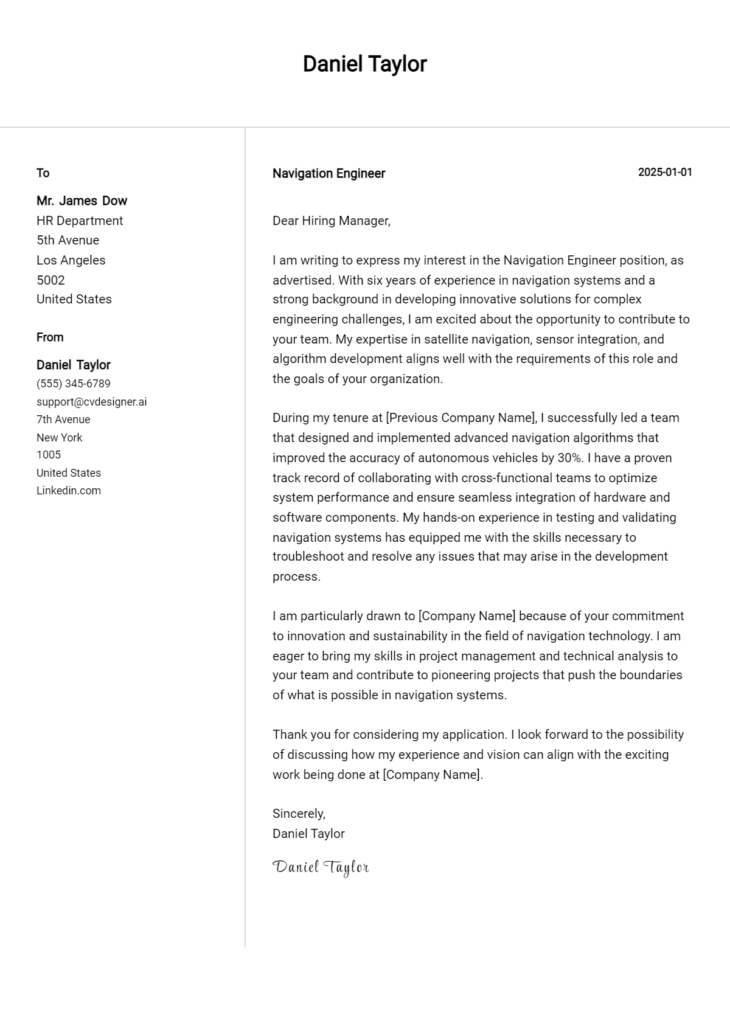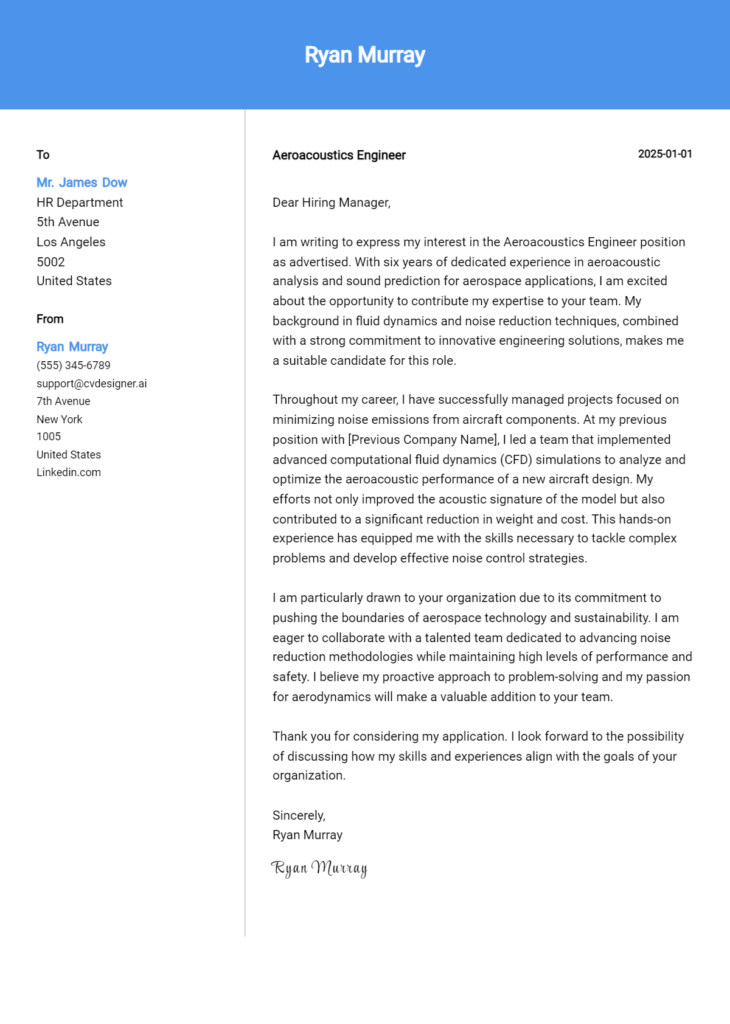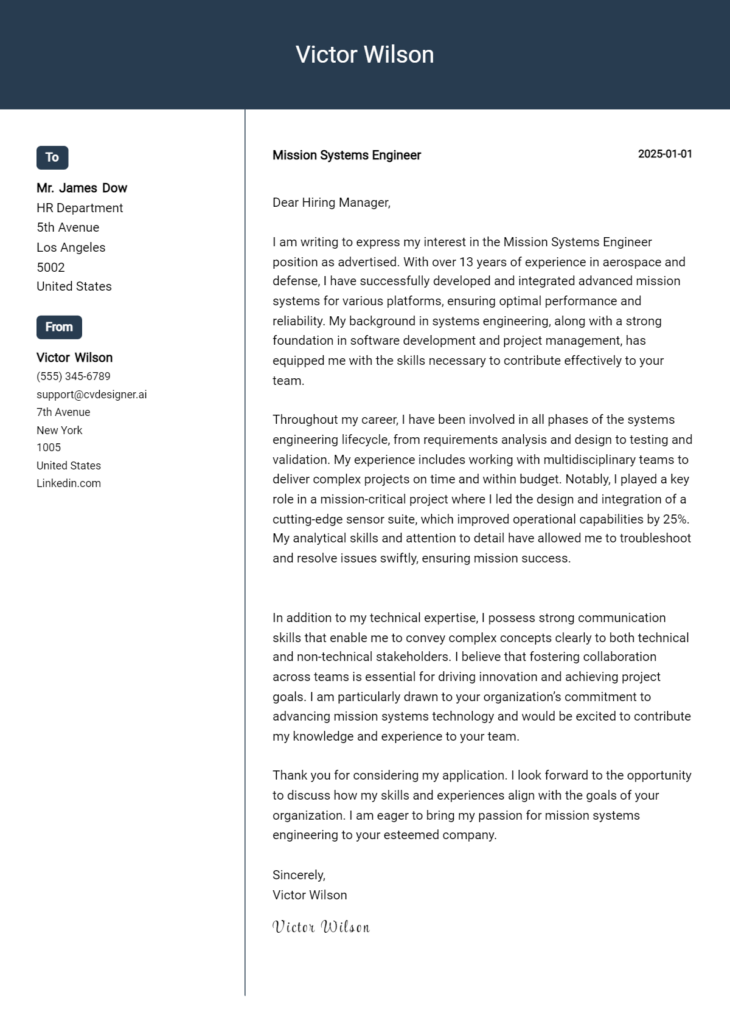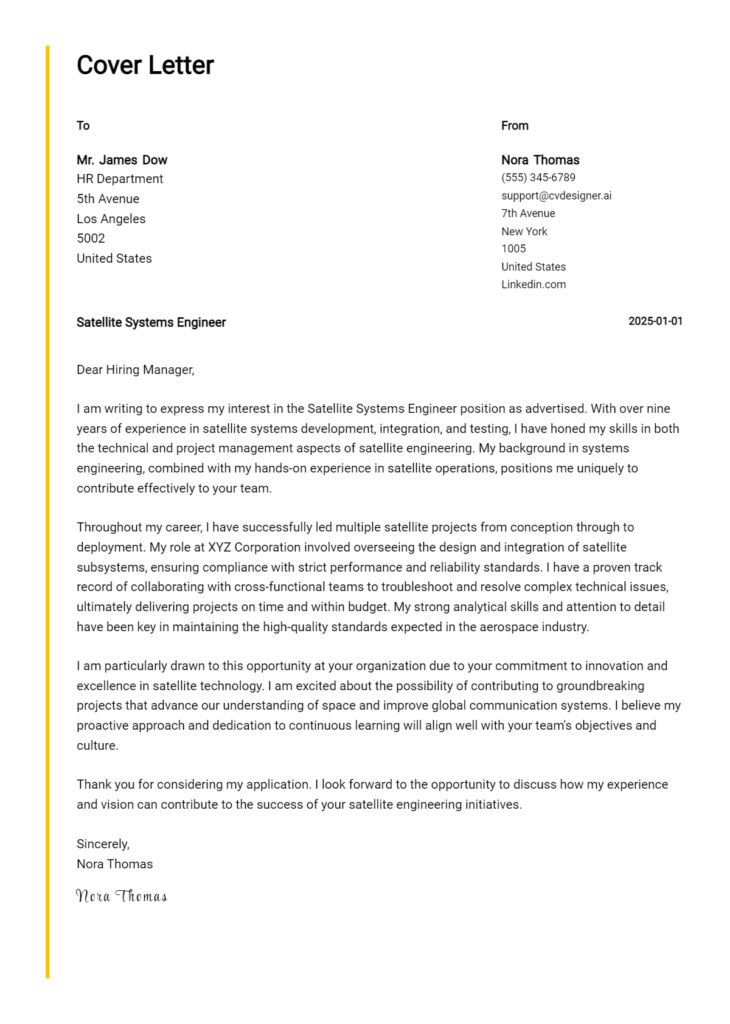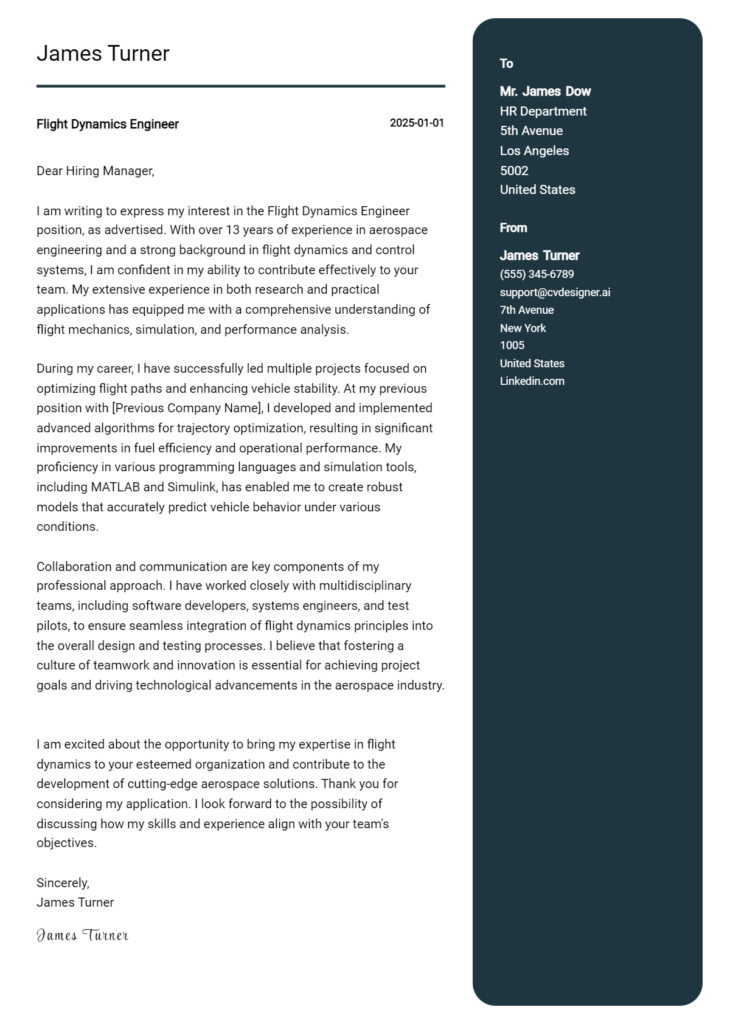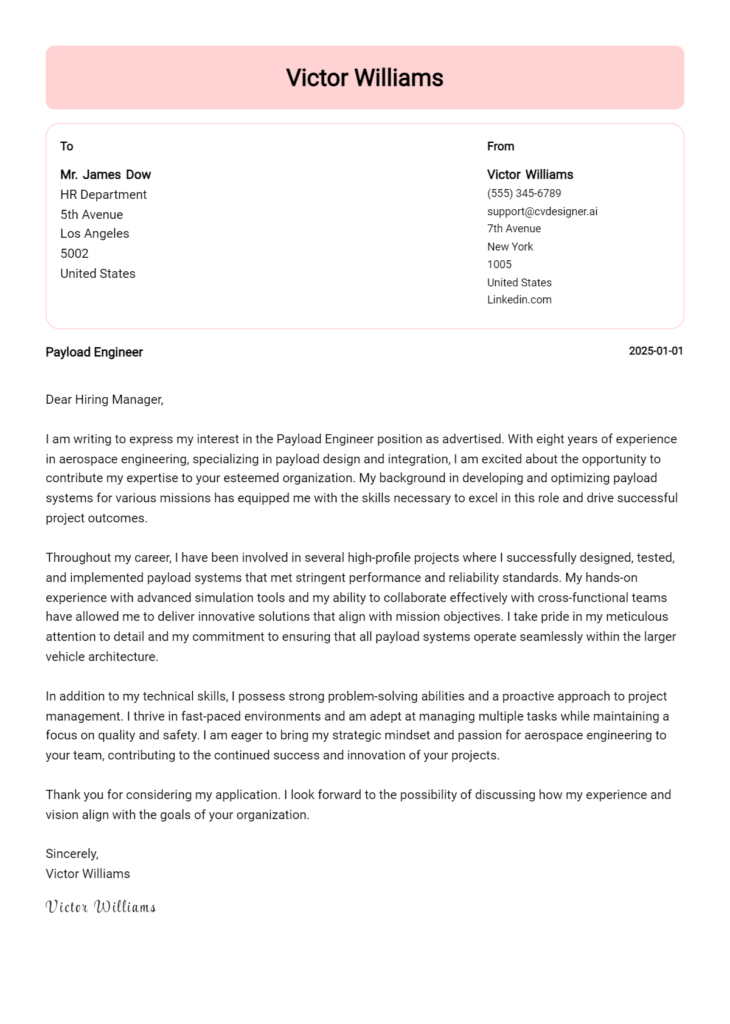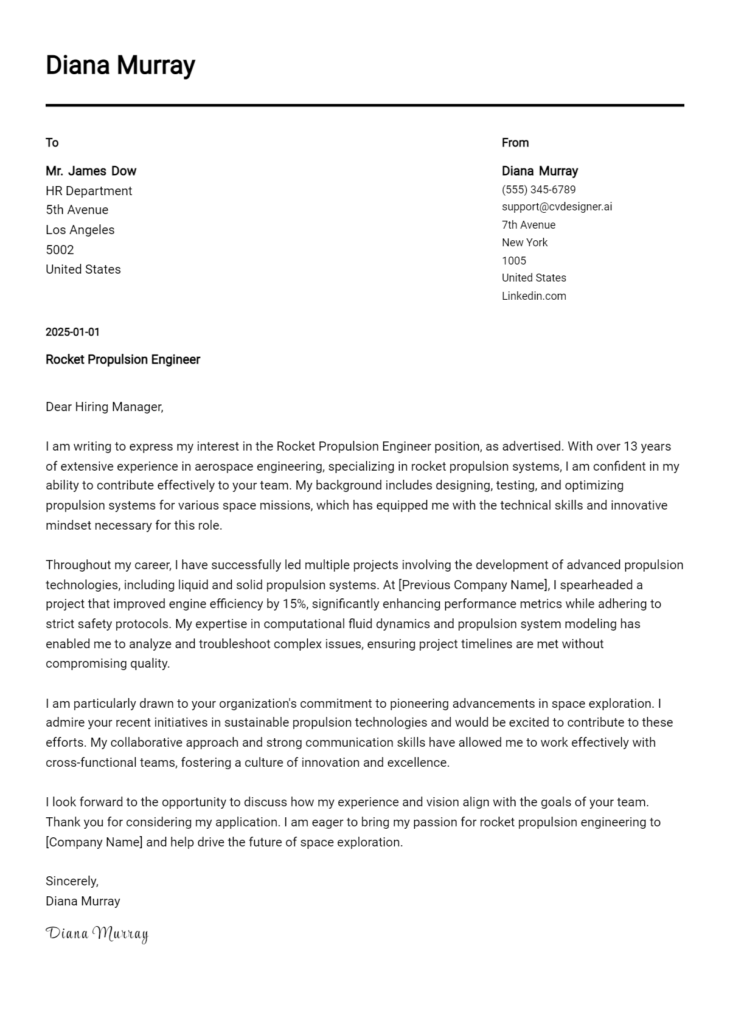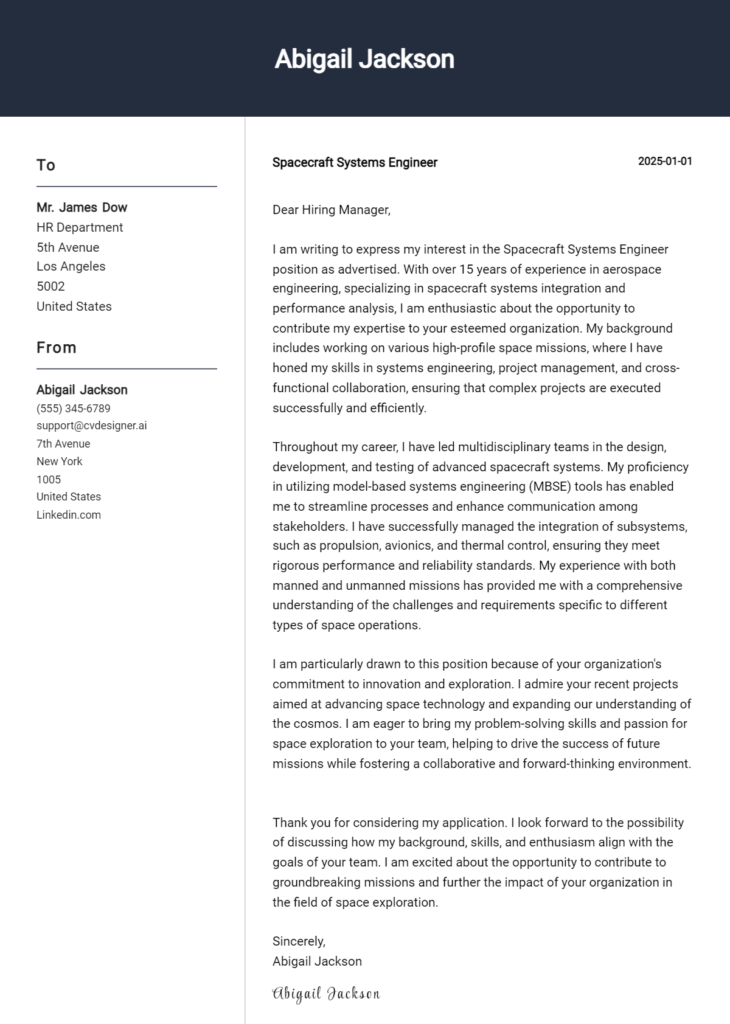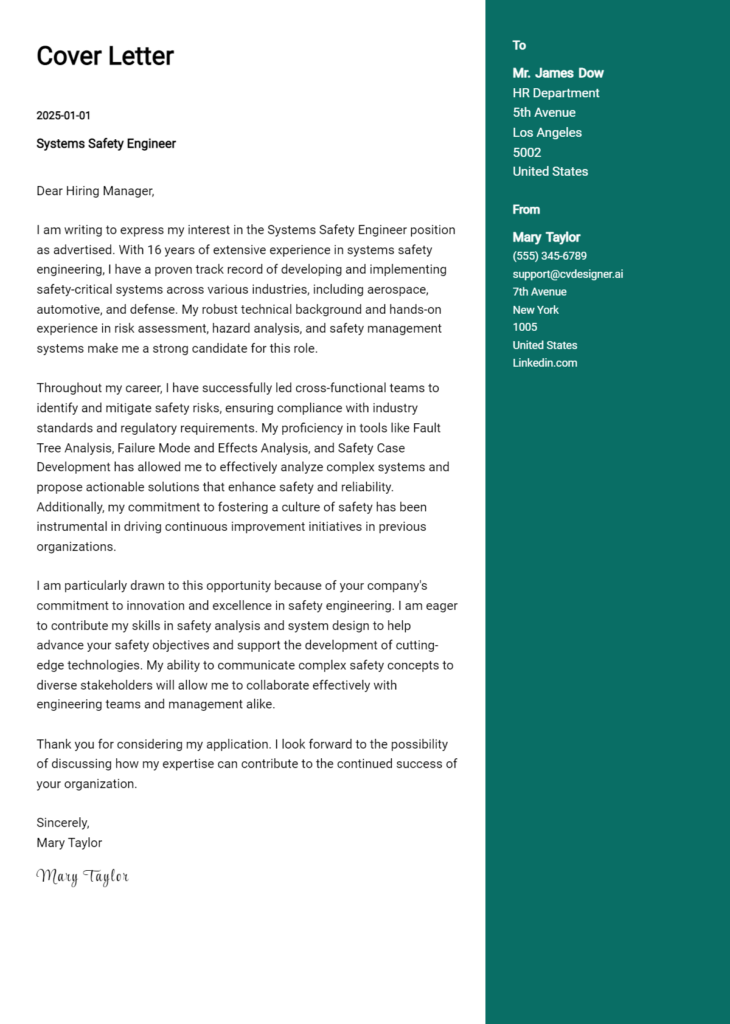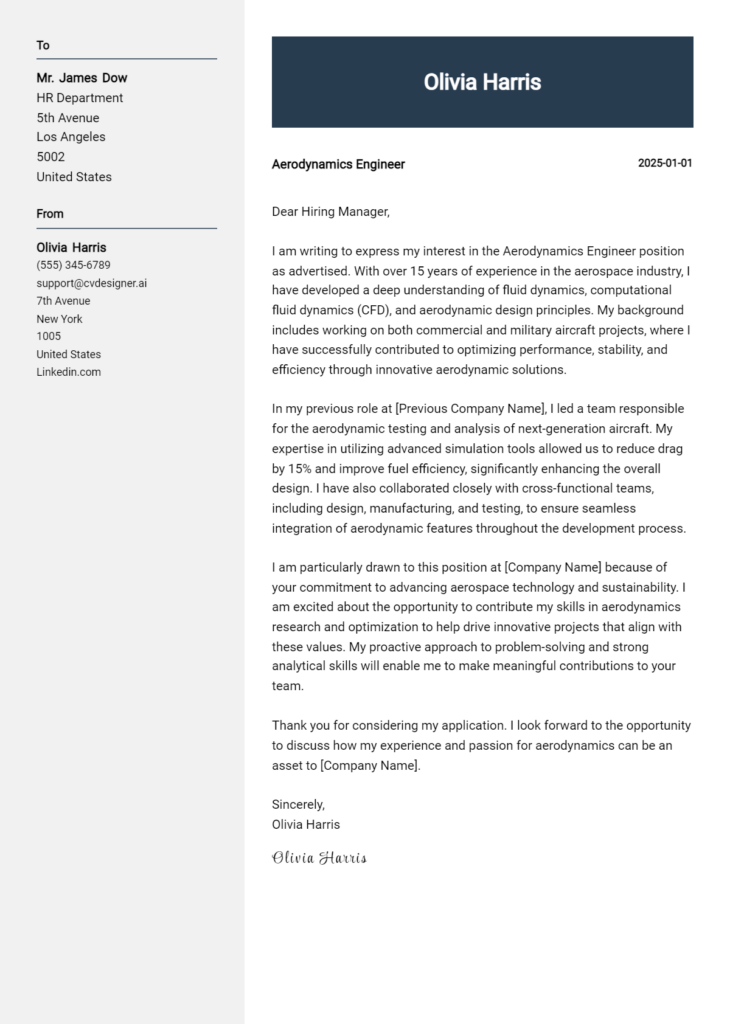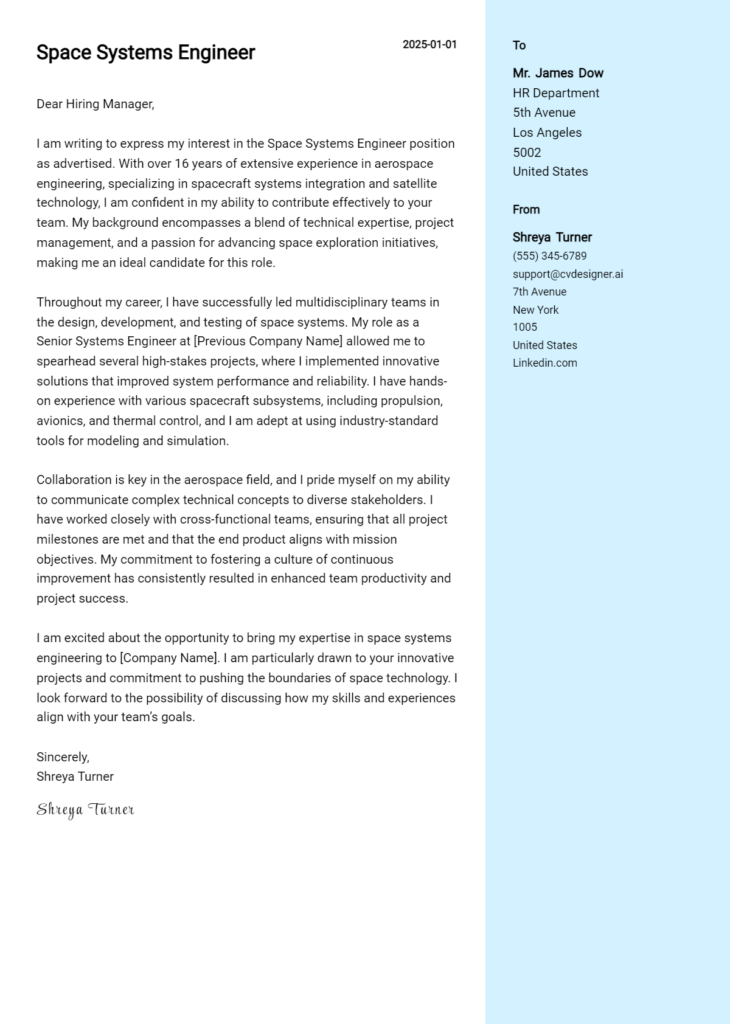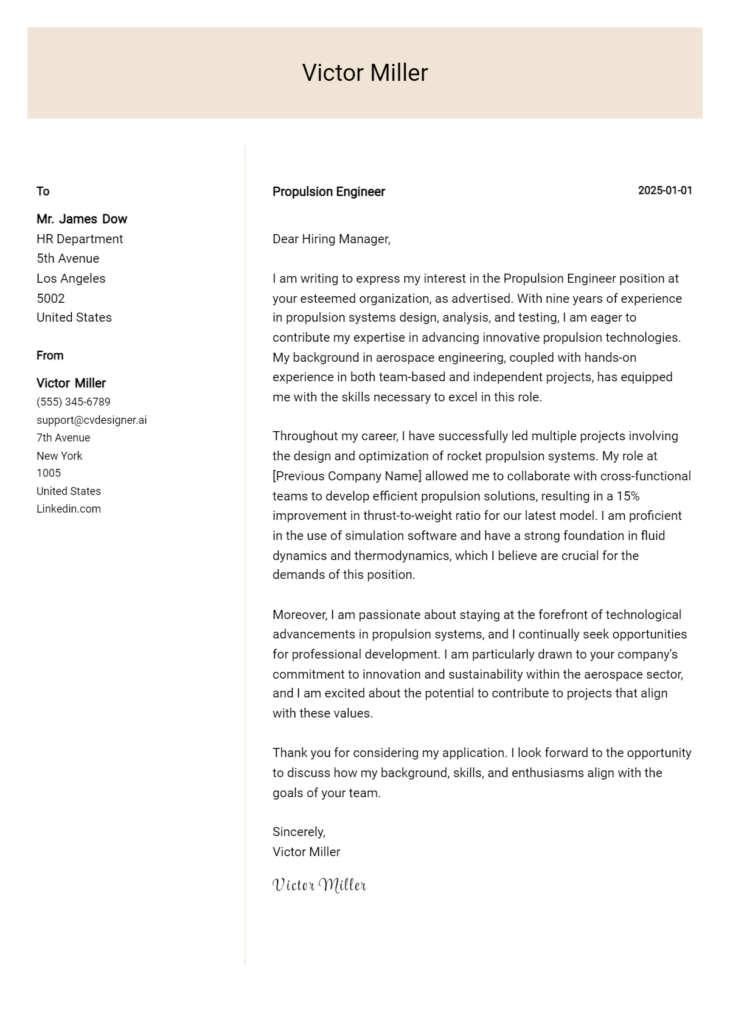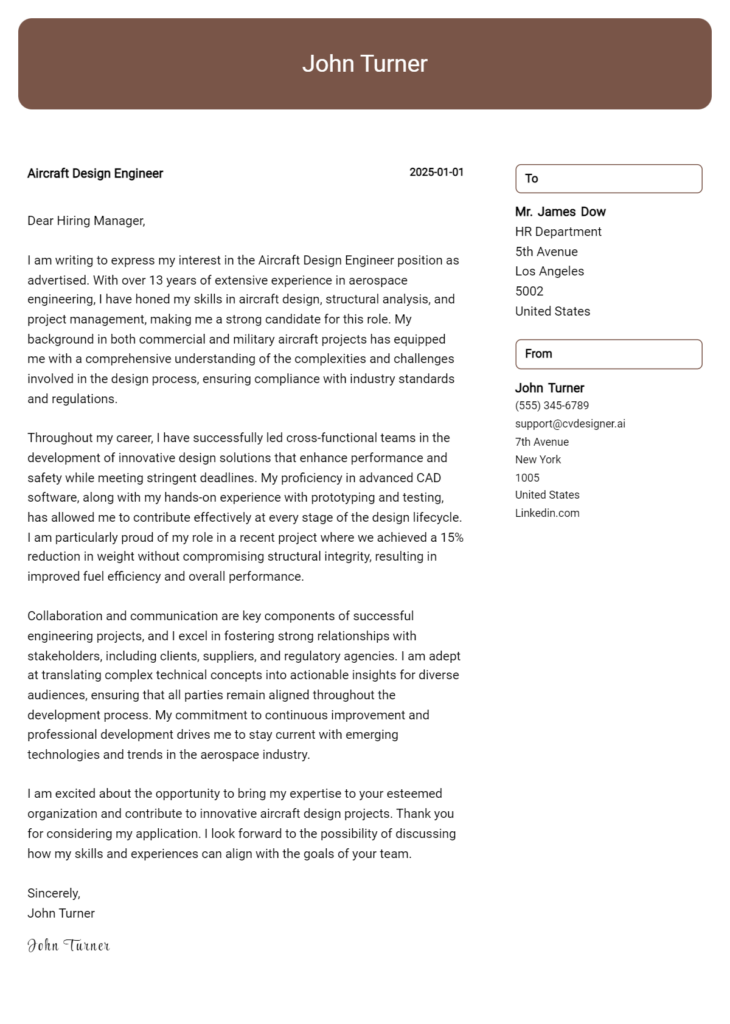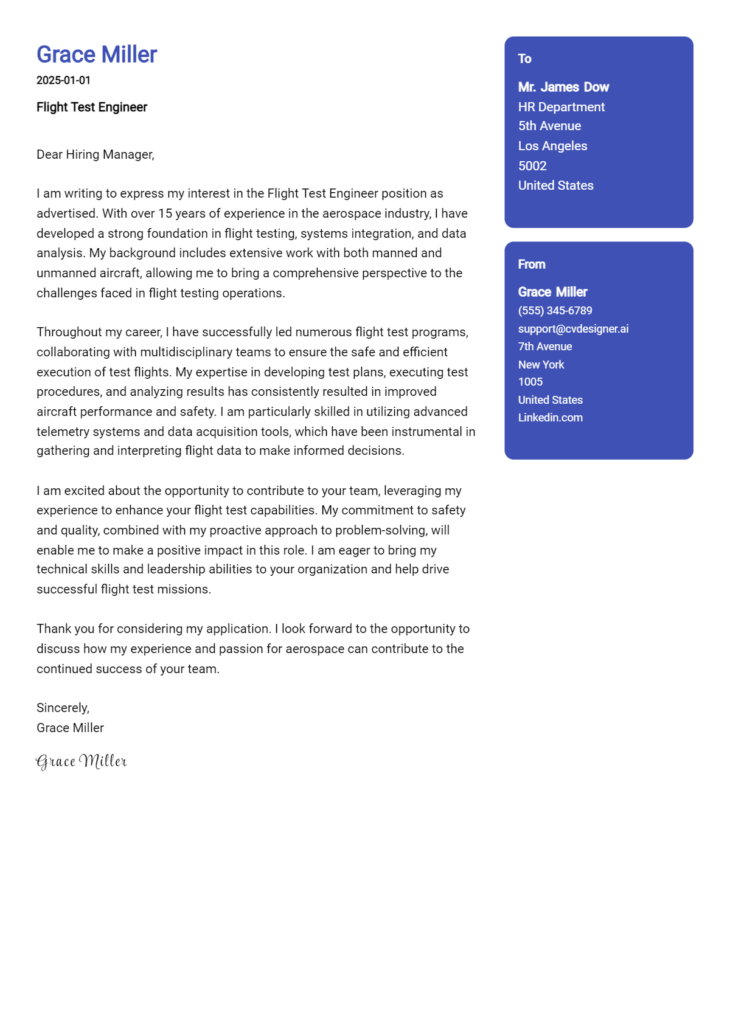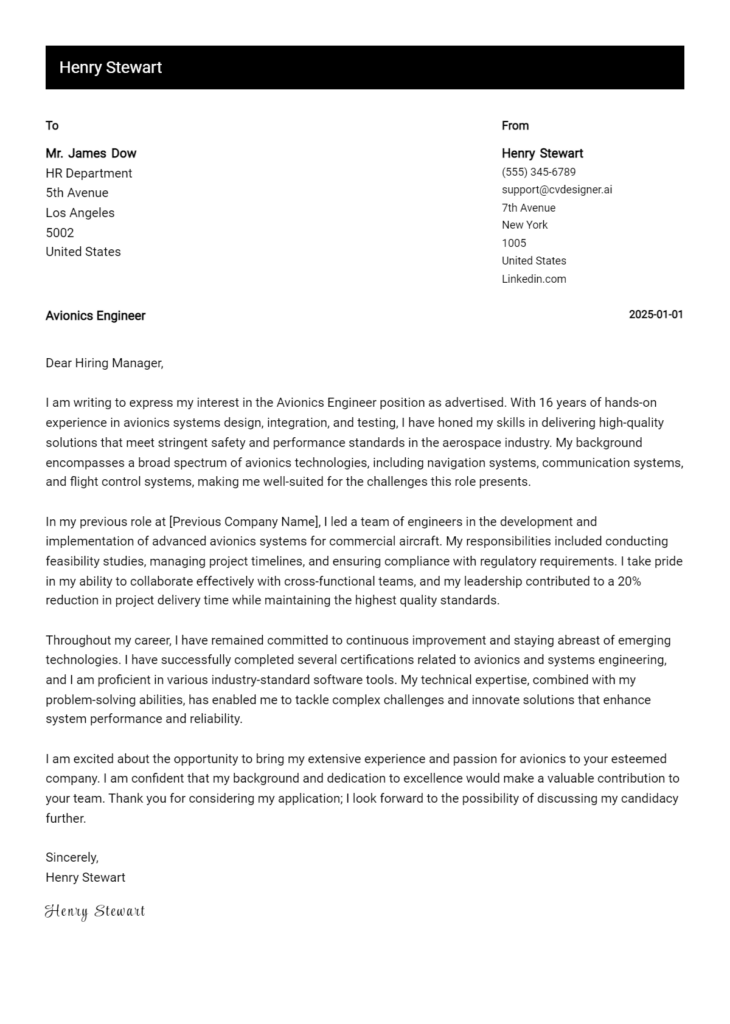Aerospace Materials Engineer Cover Letter Examples
Explore additional Aerospace Materials Engineer cover letter samples and guides and see what works for your level of experience or role.
How to Format an Aerospace Materials Engineer Cover Letter
Crafting a well-structured cover letter is essential for an Aerospace Materials Engineer, as it not only communicates your qualifications but also reflects your technical expertise and attention to detail. In a field where precision and innovation are paramount, the format of your cover letter can significantly impact how hiring managers perceive your candidacy. A clear and organized presentation helps to demonstrate your ability to analyze complex materials and processes, showcasing the meticulous nature required in aerospace engineering.
In this guide, we will outline the key components of a professional cover letter, providing insights and aerospace-specific examples to help you create an engaging document.
We will focus on the essential elements of a compelling cover letter, including:
- Cover Letter Header
- Cover Letter Greeting
- Cover Letter Introduction
- Cover Letter Body
- Cover Letter Closing
Each section is crucial for highlighting your qualifications and professionalism. Let’s delve into each part and explore how to make your aerospace materials engineer cover letter stand out.
Importance of a Cover Letter Header for an Aerospace Materials Engineer
The cover letter header is a critical component of your job application as an Aerospace Materials Engineer. It serves as the first impression and sets the tone for your professionalism and attention to detail. A well-structured header should include your contact information, the date, and the recipient's details, ensuring clarity and accessibility. This organization not only reflects your ability to communicate effectively—a key skill in engineering—but also demonstrates respect for the recipient's time. A strong header can enhance your credibility, while a weak one can diminish your chances of making a favorable impression.
Strong Example
John Doe 1234 Aerospace Lane Engineering City, CA 12345 (123) 456-7890 john.doe@email.com October 20, 2023 Hiring Manager Aerospace Innovations Inc. 5678 Engineering Ave Tech Town, CA 67890
Weak Example
John D. 10/20/23 To Whom It May Concern,
The Importance of a Cover Letter Greeting for Aerospace Materials Engineer
The greeting of your cover letter plays a crucial role in setting the tone for the rest of your application. A well-crafted greeting demonstrates professionalism and a personal touch, which can make a significant difference in how your letter is received by the hiring manager. Addressing the recipient directly shows that you have taken the time to research their name and position, reflecting your enthusiasm for the role and respect for the organization. To avoid generic greetings that may come off as impersonal, it's essential to invest a little effort into finding the right contact person. If the job listing does not provide a name, consider looking on the company's website or LinkedIn to identify the hiring manager.
Here are some strong and weak examples of greetings for an Aerospace Materials Engineer cover letter:
Strong Greeting Example
Dear Dr. Sarah Johnson,
Weak Greeting Example
To Whom It May Concern,
The Importance of a Strong Cover Letter Introduction for an Aerospace Materials Engineer
A well-crafted cover letter introduction is crucial for an Aerospace Materials Engineer as it serves as the first impression for the hiring manager. This introductory paragraph should capture attention, express genuine interest in the position, and provide a glimpse into the candidate's relevant skills or achievements. A strong introduction can differentiate a candidate from others by making a memorable impact, while a weak one may lead to a missed opportunity. The goal is to entice the reader to continue, showcasing the candidate as the ideal fit for the role.
Strong Example
Dear [Hiring Manager's Name], I am excited to apply for the Aerospace Materials Engineer position at [Company Name]. With over five years of experience in developing advanced composite materials and a proven track record of enhancing aircraft performance through innovative design, I am eager to contribute my expertise to your esteemed team. My recent project, which improved the material efficiency of a leading aerospace component by 30%, exemplifies my commitment to pushing boundaries in aerospace technology and aligns perfectly with [Company Name]'s mission to lead in aerospace innovation.
Weak Example
Dear [Hiring Manager's Name], I am writing to apply for the Aerospace Materials Engineer position at your company. I have some experience in materials engineering, and I think I could do a good job. I recently worked on a project related to aerospace materials, but I don't remember the details. I hope you consider my application.
Purpose of the Cover Letter Body for an Aerospace Materials Engineer
The cover letter body for an Aerospace Materials Engineer serves as a critical platform for candidates to articulate their technical expertise, relevant experiences, and how they can contribute to the prospective employer's goals. It allows the candidate to highlight specific projects or accomplishments that demonstrate their problem-solving capabilities, innovative thinking, and proficiency in materials selection and testing. By detailing their achievements, such as the successful implementation of lightweight materials that improved aircraft fuel efficiency or participation in a groundbreaking research project on composite materials, candidates can effectively convey their value to the hiring organization.
Strong Example
I am excited to apply for the Aerospace Materials Engineer position at ABC Aerospace. In my previous role at XYZ Corp, I led a team that successfully developed a new titanium alloy that reduced weight by 20% while maintaining structural integrity. This project not only enhanced our product performance but also resulted in a significant cost reduction in manufacturing processes. Additionally, I collaborated with cross-functional teams to implement advanced testing protocols that improved material reliability under extreme conditions, demonstrating my commitment to innovation and excellence in aerospace engineering.
Weak Example
I am applying for the Aerospace Materials Engineer role. I have worked in engineering for several years and have some experience with materials. I believe I can do a good job. I worked on a few projects, but I can't remember the details. I am a hard worker and willing to learn new things, which I think is important for this position.
Importance of the Cover Letter Closing for an Aerospace Materials Engineer
The closing paragraph of a cover letter is crucial for leaving a lasting impression on the hiring manager. It provides an opportunity to summarize key qualifications, reiterate enthusiasm for the position, and encourage the next steps, such as reviewing the resume or scheduling an interview. A strong closing can reinforce the candidate's suitability for the aerospace materials engineer role and motivate the employer to take action, while a weak closing may fail to convey confidence and interest, potentially leading to missed opportunities.
Strong Example
In conclusion, my extensive experience in materials selection and testing, combined with my passion for advancing aerospace technologies, makes me an ideal candidate for this position. I am eager to bring my skills in composite materials and failure analysis to your esteemed team at [Company Name]. I look forward to the opportunity to discuss how my background aligns with your needs and to explore how I can contribute to innovative projects at [Company Name]. Thank you for considering my application; I hope to speak with you soon regarding the next steps.
Weak Example
Thank you for reading my cover letter. I think I would be a good fit for the aerospace materials engineer job. Please look at my resume. I hope to hear from you.
These tips will help candidates craft an effective cover letter for an Aerospace Materials Engineer position. A well-written cover letter is crucial in highlighting your technical skills, problem-solving abilities, understanding of the Software Development Life Cycle (SDLC), teamwork experience, and your passion for continuous learning in the aerospace field. By effectively showcasing these attributes, you can set yourself apart from other candidates and demonstrate your suitability for the role.
Tips for Writing a Compelling Cover Letter
Highlight Technical Skills
Aerospace Materials Engineers must possess a robust set of technical skills. In your cover letter, clearly outline your expertise in materials science, engineering principles, and any software or tools you are proficient in, such as CAD software or simulation tools. Use specific examples that demonstrate how you applied these skills in previous projects. This will show potential employers that you have the hands-on experience necessary for the job.Demonstrate Problem-Solving Abilities
Problem-solving is a critical aspect of engineering. When writing your cover letter, include instances where you successfully identified and solved complex problems related to material selection or testing methodologies. Highlight your analytical thinking and how your solutions positively impacted project outcomes. This not only showcases your abilities but also reflects your proactive approach to challenges.Showcase SDLC Knowledge
Understanding the Software Development Life Cycle (SDLC) is essential, especially if your role involves integrating software solutions with material engineering processes. Discuss any experience you have with project management methodologies or software development practices. Emphasize how your knowledge of SDLC helps ensure that projects are completed efficiently and meet quality standards.Emphasize Teamwork and Collaboration
Aerospace projects often require collaboration across various disciplines. Illustrate your experience working in teams by sharing examples of successful collaborations with other engineers, designers, or multidisciplinary teams. Highlight your communication skills and how you contribute to a positive team environment, ensuring that projects progress smoothly and effectively.Express a Passion for Continuous Learning
The aerospace industry is constantly evolving, and a commitment to continuous learning is vital. In your cover letter, mention any relevant certifications, courses, or workshops you have completed recently. Discuss your enthusiasm for staying updated with the latest advancements in materials technology and how you plan to further your expertise. This will convey your dedication to professional growth and your eagerness to contribute to innovative solutions in the field.
For additional resources, consider using cover letter templates or a cover letter builder to help you create a polished and professional document that stands out.
Common Mistakes to Avoid in a Aerospace Materials Engineer Cover Letter
Crafting a compelling cover letter is vital for standing out in the competitive field of aerospace engineering. Avoiding common pitfalls can significantly enhance your chances of making a positive impression on potential employers. Here are some common mistakes to steer clear of, along with tips to avoid them:
Generic Salutation: Using "To Whom It May Concern" can make your letter seem impersonal. Always try to find the name of the hiring manager. If unavailable, “Dear Hiring Team” is a better alternative.
Lack of Specificity: Vague statements about your experience won't resonate. Instead, be specific about your skills and how they relate to the job. For example, mention your expertise in composite materials relevant to aerospace applications.
Rehashing Your Resume: Your cover letter should complement your resume, not repeat it. Highlight key achievements and how they align with the job responsibilities instead of listing all your past jobs.
Ignoring the Job Description: Failing to tailor your cover letter to the specific position can make you seem disinterested. Analyze the job description and incorporate the key requirements into your letter.
Poor Formatting: A cluttered or overly complicated format can distract from your message. Ensure your cover letter adheres to professional cover letter format standards, with clear sections and a readable font.
Typos and Grammatical Errors: Mistakes in spelling or grammar can undermine your professionalism. Always proofread your letter multiple times, and consider using tools or asking a friend to review it.
Neglecting to Show Passion: A lack of enthusiasm for the field can be off-putting. Share why you are passionate about aerospace materials engineering and how it aligns with your career goals.
By addressing these common mistakes and following the tips provided, you can create a standout cover letter that effectively showcases your qualifications and enthusiasm for the role. For further insights and inspiration, explore some cover letter examples that can guide your writing process.
Cover Letter FAQs for Aerospace Materials Engineer
What should I include in my cover letter as an Aerospace Materials Engineer?
In your cover letter, you should highlight your relevant education, experience, and specific skills that align with the job description. Start with a strong introduction that outlines your interest in the position and the company. Discuss your background in materials science or engineering, focusing on projects or roles that involved aerospace applications. Mention any experience with material testing, analysis, or selection, as well as familiarity with industry standards. Additionally, include examples of teamwork or collaboration in multidisciplinary settings, showcasing your ability to communicate effectively with engineers and designers. Finally, express your enthusiasm for contributing to innovative aerospace solutions and your understanding of the company’s goals.
How can I tailor my cover letter for a specific aerospace company?
To tailor your cover letter for a specific aerospace company, start by researching the company’s mission, values, and recent projects. Identify any keywords or phrases in the job description and incorporate them into your letter to demonstrate that you understand the company's needs. Mention any relevant experience that directly relates to the company’s current projects or challenges. Additionally, highlight your knowledge of their products or technologies, and express how your skills can add value to their team. This personalized approach shows that you are genuinely interested in the position and have taken the time to understand the company's work and culture.
Should I include technical jargon in my cover letter?
While it’s important to demonstrate your technical expertise in your cover letter, be mindful of your audience. If the hiring manager is an engineer or someone familiar with aerospace materials, using relevant technical jargon can showcase your knowledge. However, avoid overly complex terminology that may not be understood by non-technical readers involved in the hiring process. Aim for a balance by explaining key concepts succinctly, ensuring clarity while still demonstrating your proficiency in aerospace materials. Additionally, always relate technical terms back to their practical implications or benefits to the projects or goals of the company.
How do I demonstrate my problem-solving skills in my cover letter?
To effectively demonstrate your problem-solving skills in your cover letter, provide specific examples of challenges you faced in previous roles and how you addressed them. Use the STAR method (Situation, Task, Action, Result) to structure your examples. For instance, describe a situation where you had to select a new material for a project, the task you were assigned, the actions you took to analyze and test various options, and the successful outcome of your decision. Highlight any innovative solutions you developed and the positive impact they had on project efficiency, safety, or performance. This not only illustrates your problem-solving capabilities but also reinforces your suitability for the Aerospace Materials Engineer role.
Build your Cover Letter in minutes
Use an AI-powered cover letter builder and have your letter done in 5 minutes. Just select your template and our software will guide you through the process.

